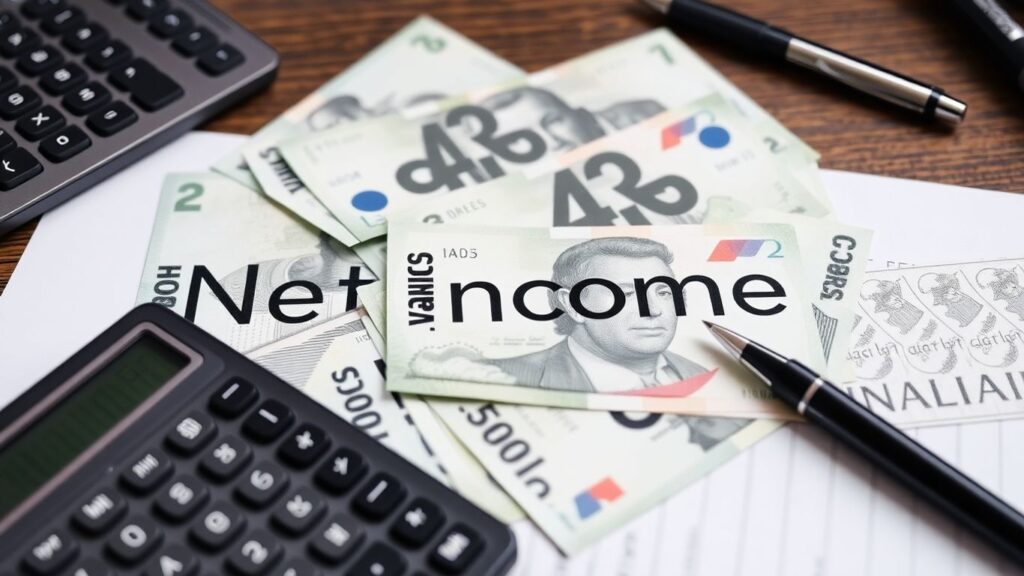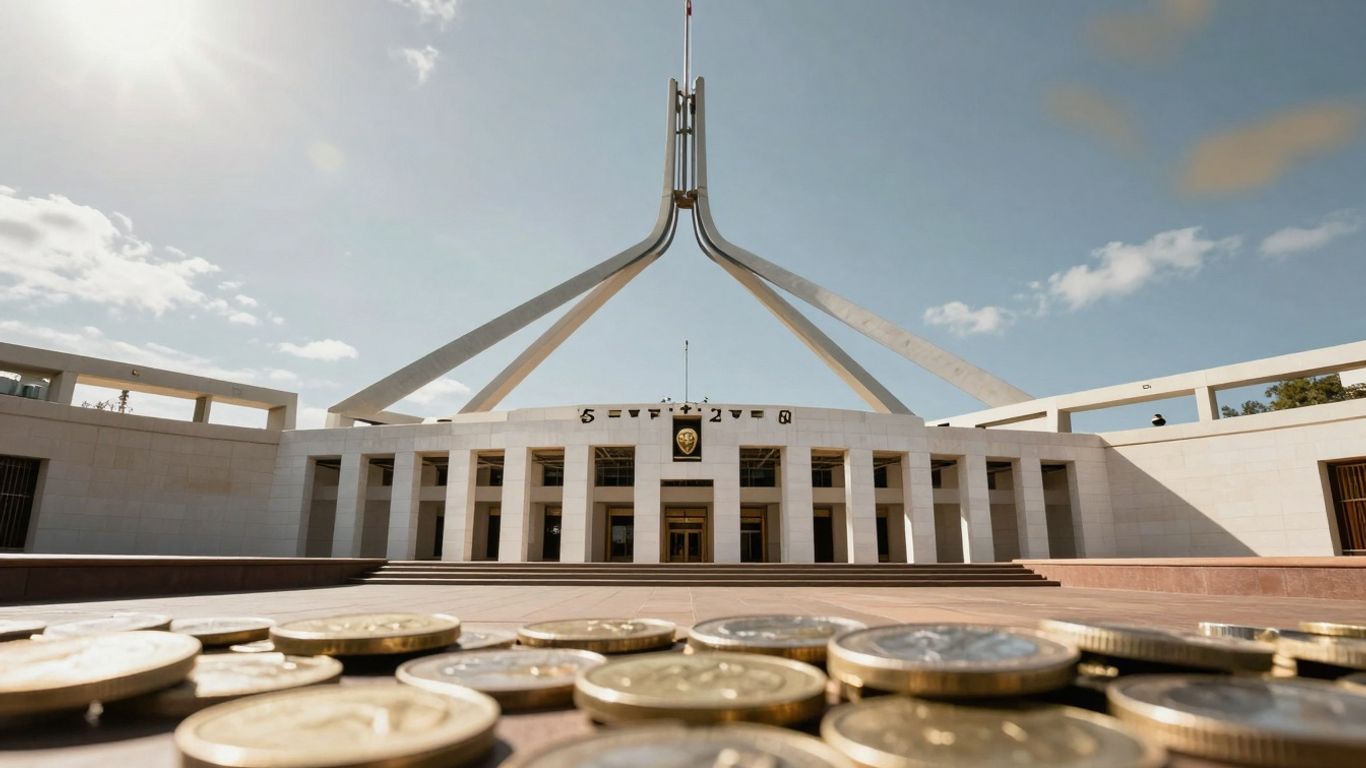So, you’re earning $100,000 a year in Australia. Sounds like a pretty good deal, right? But what actually hits your bank account after the taxman takes his cut? It’s not as simple as just subtracting a flat percentage. Australia’s tax system has different rates and levies that can be a bit confusing. We’re going to break down what $100,000 after tax really looks like, so you can get a clearer picture of your actual earnings and figure out how to make the most of them.
Key Takeaways
- Earning $100,000 in Australia means you’ll likely pay around $24,967 in income tax and the Medicare Levy, leaving you with approximately $75,033 in net pay.
- Your average tax rate on $100,000 is about 25%, but your marginal tax rate is 32.5% (plus the Medicare Levy), meaning any extra dollar earned above $45,000 is taxed at this higher rate.
- Claiming work-related expenses and other eligible deductions can lower your taxable income, which in turn reduces the total tax you pay.
- A tax return is your annual chance to tell the ATO about your income and expenses, allowing you to claim back any tax overpaid through deductions and offsets.
- Understanding your tax obligations, knowing when to lodge a return, and exploring ways to reduce your taxable income can help you manage your finances better and potentially keep more of your hard-earned money.
Understanding Your $100,000 After Tax Income
So, you’ve hit that $100,000 a year mark. That sounds pretty good, right? But what does that actually mean in your bank account after the taxman takes his cut? It’s not as simple as just subtracting a flat percentage. Australia has a progressive tax system, which means the more you earn, the higher the rate of tax you pay on those extra dollars. Understanding these brackets and how they apply to your $100,000 salary is the first step to figuring out your real take-home pay.
Navigating Australia’s Progressive Tax System
Australia’s tax system is structured in ‘brackets’. Each bracket applies to a different portion of your income. The higher the bracket, the higher the tax rate for that specific chunk of your earnings. It’s important to remember that you don’t pay the highest rate on your entire income; only on the amount that falls into that highest bracket. This system is designed so that those earning more contribute a larger proportion of their income to government revenue.
How Tax Brackets Affect Your Earnings
Let’s break down how tax is calculated on a $100,000 salary for the 2023-2024 financial year. Remember, these figures are before any deductions or offsets are considered.
| Income Bracket | Tax Rate | Tax Payable on this Bracket |
|---|---|---|
| $0 – $18,200 | 0% | $0 |
| $18,201 – $45,000 | 19% | 19% of income over $18,200 |
| $45,001 – $120,000 | 32.5% | $5,092 plus 32.5% of income over $45,000 |
For someone earning $100,000:
- The first $18,200 is taxed at 0%.
- The portion from $18,201 to $45,000 ($26,800) is taxed at 19%, costing $5,092.
- The portion from $45,001 to $100,000 ($55,000) is taxed at 32.5%, costing $17,875.
So, the total income tax on $100,000 is $5,092 + $17,875 = $22,967.
The Impact of the Medicare Levy
On top of income tax, most Australians also pay the Medicare Levy. For the 2023-2024 financial year, this is generally 2% of your taxable income. This levy helps fund Australia’s public healthcare system.
For a $100,000 income, the Medicare Levy would be $100,000 * 2% = $2,000.
This means that your total compulsory payments (income tax plus Medicare Levy) on a $100,000 salary, before any deductions or offsets, come to $22,967 + $2,000 = $24,967. This leaves you with approximately $75,033 in net pay.
Calculating Your Take-Home Pay
So, you’ve earned $100,000. That sounds like a lot, right? But before you start planning that overseas trip, we need to talk about what actually lands in your bank account after the taxman takes his cut. It’s not just income tax, either; there’s the Medicare Levy to consider, and understanding these figures helps you get a real handle on your finances.
Gross Salary vs. Net Income
It’s easy to think of your gross salary as your actual earnings, but the reality is that taxes and levies reduce that figure considerably. Knowing your tax liability upfront helps in budgeting and financial planning. Your gross salary is the total amount your employer agrees to pay you before any deductions are made. Your net income, on the other hand, is the amount that actually gets deposited into your bank account – what’s left after all the mandatory deductions like income tax and the Medicare Levy are taken out. The difference between gross and net income is where the bulk of your tax obligations lie.
Income Tax Breakdown on $100,000
Australia has a progressive tax system, meaning the more you earn, the higher the tax rate applied to those extra dollars. For the 2023-2024 financial year, here’s how a $100,000 salary is taxed, excluding any personal deductions or offsets:
- $0 – $18,200: No tax payable.
- $18,201 – $45,000: You pay 19% on the portion of your income within this range. This amounts to ($45,000 – $18,200) * 19% = $5,092.
- $45,001 – $100,000: You pay 32.5% on the portion of your income within this range. This amounts to ($100,000 – $45,000) * 32.5% = $17,875.
So, your total income tax before the Medicare Levy is $5,092 + $17,875 = $22,967.
Your Actual Net Pay After Levies
On top of income tax, most Australians pay the Medicare Levy. This is currently set at 2% of your taxable income and helps fund our public healthcare system. For someone earning $100,000, this adds an extra $2,000 ($100,000 * 2%).
Therefore, your total tax and levies on a $100,000 salary, before any deductions, comes to $22,967 (income tax) + $2,000 (Medicare Levy) = $24,967. This leaves you with $75,033 in net pay.
Here’s a quick summary:
| Item | Amount |
|---|---|
| Gross Salary | $100,000 |
| Income Tax | -$22,967 |
| Medicare Levy | -$2,000 |
| Net Pay | $75,033 |
This means that after all the mandatory taxes and levies are accounted for, you’re left with approximately $75,033 per year, or about $6,253 per month. It’s a significant chunk, but understanding where it goes is key to managing your finances effectively.
Marginal vs. Average Tax Rates Explained

It’s super easy to get your tax rates mixed up, especially when you’re looking at your pay. You’ve got your gross salary, and then there’s what actually hits your bank account. But understanding how the tax system works, particularly the difference between your marginal and average tax rates, is key to knowing where your money is going.
What is Your Marginal Tax Rate?
Think of your marginal tax rate as the tax you’ll pay on the next dollar you earn. It’s the rate applied to the highest portion of your income. For someone earning $100,000 a year in Australia, the marginal tax rate is 32.5%. This doesn’t mean you pay 32.5% on your entire $100,000. Instead, only the income that falls into that specific tax bracket is taxed at that rate. So, if you get a bonus or a pay rise, that extra money will be taxed at your marginal rate. This is why people sometimes worry about getting a pay rise, but in reality, any increase in income will always mean more money in your pocket, even after tax.
Understanding Your Average Tax Rate
Your average tax rate is a bit different. It’s the total amount of tax you’ve paid throughout the year divided by your total taxable income. For someone earning $100,000, the average tax rate works out to be around 25%. This gives you a broader picture of how much of your income, on average, is going towards taxes. It’s a useful figure for understanding your overall tax burden, but it’s the marginal rate that affects any additional income you might earn.
Here’s a simple breakdown for a $100,000 income (excluding Medicare Levy for simplicity):
| Income Bracket | Tax Rate | Tax Paid in Bracket |
|---|---|---|
| $0 – $18,200 | 0% | $0 |
| $18,201 – $45,000 | 19% | $5,092 |
| $45,001 – $100,000 | 32.5% | $17,875 |
| Total Tax Paid | $22,967 |
How Extra Income is Taxed
When you earn more money, whether it’s through overtime, a bonus, or a salary increase, that extra income is taxed at your marginal rate. This is a really important concept because it clarifies how pay rises affect your take-home pay. You don’t suddenly jump into a higher tax bracket for all your income; only the portion above certain thresholds is taxed at the higher rates. So, if you earn an extra $1,000, it will be taxed at 32.5% (plus the Medicare Levy), meaning you’ll keep $675 of that $1,000. It’s always better to earn more, even with the tax implications. Understanding this helps you make better decisions about your career progression.
It’s easy to get confused between your marginal tax rate (applied to the next dollar earned) and your average tax rate (total tax divided by total income). This confusion often leads people to fear pay rises, believing they will be pushed into a higher tax bracket and pay more tax overall. However, only the income within the higher bracket is taxed at that rate, meaning a pay rise will always result in more take-home pay.
Knowing the difference between these rates helps you understand your tax obligations better and plan your finances more effectively. It’s not just about the big number of your salary, but how the tax system applies to each part of it.
Reducing Your Taxable Income
So, you’ve got your $100,000 salary, and you’re probably wondering how to keep as much of that as possible. Well, one of the best ways is by looking at what you can claim back from the tax office. It’s not just about what you earn, but also about the legitimate expenses you have in earning that money. Think of it as getting a bit of a discount on your tax bill.
The Role of Work-Related Deductions
Basically, work-related deductions are expenses you’ve paid for that directly help you do your job. If you’ve bought things like a specific tool for your trade, a uniform that’s required for work, or even paid for a course that improves your skills for your current job, you can often claim these costs. When you claim these, you’re telling the Australian Taxation Office (ATO) that you spent money to earn your income. This reduces your ‘taxable income’ – the amount the government uses to calculate how much tax you owe. So, if your salary is $100,000 and you have $3,000 in valid deductions, your taxable income drops to $97,000. This means you’ll pay tax on a smaller amount, which is a good thing. It’s a pretty straightforward way to keep more of your hard-earned cash.
Common Deductions to Consider
There are heaps of things people can claim, but it really depends on your job. Here are a few common areas:
- Uniforms and Protective Clothing: If your employer requires you to wear a specific uniform or protective gear, you can usually claim the cost of buying, repairing, or cleaning it. Just make sure it’s not just a regular piece of clothing you wear outside of work.
- Tools and Equipment: If you need specific tools or equipment to do your job, and your employer doesn’t provide them, you might be able to claim a deduction for them. The amount you can claim might depend on how much you use them for work versus personal use.
- Self-Education Expenses: If you’re studying a course that relates directly to your current job and it helps you earn more or improve your skills in that job, you can often claim the costs. This includes things like course fees, textbooks, and even travel expenses related to your study.
- Home Office Expenses: If you work from home, you might be able to claim a portion of your running costs, like electricity, internet, and even the depreciation of your home office equipment. There are different ways to calculate this, so it’s worth looking into the ATO’s methods.
- Travel Expenses: If your job requires you to travel between different work locations, or if you have to travel for work-related training or conferences, you might be able to claim those costs.
Keeping Records for Tax Claims
This is super important. You can’t just say you spent money; you need proof. The ATO requires you to keep records, like receipts, invoices, and bank statements, for at least five years after you lodge your tax return. Without good records, your deduction claims might not be accepted, and you could end up owing more tax than you expected. It’s a bit of a hassle, sure, but it’s way better than missing out on money you’re entitled to or getting in trouble with the tax office.
It’s always a good idea to have a system for keeping track of your work-related expenses throughout the year. A simple folder or a digital system can make tax time much less stressful and help you claim everything you’re eligible for.
Here’s a quick look at how claiming deductions can affect your taxable income:
| Original Taxable Income | Deductions Claimed | New Taxable Income | Estimated Tax Saved* |
|---|---|---|---|
| $100,000 | $0 | $100,000 | $0 |
| $100,000 | $2,000 | $98,000 | $650 |
| $100,000 | $5,000 | $95,000 | $1,625 |
*Estimated tax saved is based on a marginal tax rate of 32.5% plus the Medicare Levy. Actual savings can vary.
The Importance of Lodging a Tax Return
So, you’ve got your salary sorted, and you’re wondering what’s next with the tax office. This is where the tax return comes into play. Think of it as your annual financial check-in with the Australian Taxation Office (ATO). It’s how they figure out if you’ve paid the right amount of tax throughout the year, or if you’re due a refund or owe a bit more. It might sound a bit much, but it’s really just about telling the ATO what you earned and what you spent on work-related things. Lodging on time is pretty important too; missing the deadline can mean penalties, and nobody wants that. Generally, if you’re doing it yourself, it’s due by 31 October each year for the financial year that ended on 30 June. If you use a registered tax agent, they often get an extension, which can be a lifesaver if you’re busy. It’s worth checking the ATO website or asking your tax agent for the specific dates that apply to you. Getting it done on time means you won’t have to worry about late fees, and if you’re due a refund, you’ll get it sooner. It’s easy to think that once you know your salary, you know your tax. But the reality is a bit more complex. Things like deductions, offsets, and even how you earn your money can change the final amount you owe or get back. Paying attention to these details is key to making sure you’re not paying more tax than you need to. You can find resources to help you get started with lodging your tax return.
What is a Tax Return?
A tax return is basically a form where you list all your income for the financial year – that’s your salary, any side hustle money, investment earnings, you name it. You also list any deductions you’re eligible to claim. These deductions are expenses you’ve paid for that relate directly to earning your income. The ATO then uses this info to calculate your final tax bill. If you’ve already had tax taken out of your pay (which most people have), and it turns out you’ve paid more than you owe, you’ll get a refund. If you’ve paid too little, well, you’ll owe the ATO the difference. It’s a way to make sure everyone pays their fair share.
When You Need to Lodge
Most people earning over the tax-free threshold will need to lodge a tax return. But it’s not just about earning money. You might also need to lodge if:
- You had tax withheld from your pay.
- You earned any foreign income.
- You received a government payment like JobSeeker or Austudy.
- You earned money from investments or a business.
- You want to claim a refund for tax you’ve already paid.
It’s always a good idea to check with the Australian Taxation Office (ATO) or a tax professional if you’re unsure. They have tools to help you figure out if you need to lodge.
Claiming Refunds and Offsets
This is where you can potentially get a bit more money back. Claiming the right deductions and offsets is key to reducing your taxable income. The less taxable income you have, the less tax you pay. It’s pretty straightforward, really. If you spent money on things like work uniforms, professional development courses, or even a portion of your home internet bill if you worked from home, you can often claim these. The trick is to keep good records, like receipts, to back up your claims. Here’s a quick look at how the tax-free threshold works:
| Income Bracket | Tax Rate | Tax Payable on this Bracket |
|---|---|---|
| $0 – $18,200 | 0% | $0 |
| $18,201 – $45,000 | 19% | 19% of income over $18,200 |
| $45,001 – $120,000 | 32.5% | $5,092 plus 32.5% of income over $45,000 |
| $120,001 – $180,000 | 37% | $29,467 plus 37% of income over $120,000 |
| Over $180,000 | 45% | $51,667 plus 45% of income over $180,000 |
Remember, these rates don’t include the Medicare Levy. A tax refund isn’t free money; it’s money you overpaid throughout the year. Using it wisely means you’re essentially getting a head start on your financial goals.
Maximising Your Financial Wellbeing

So, you’ve got a clearer picture of what your income looks like after tax. That’s great, but what do you do with it? It’s not just about spending; it’s about making that money work for you. Think of it as a tool to build a more secure future. It’s about making smart choices now so you can relax a bit later on.
Smart Ways to Utilise Your Tax Refund
Getting a tax refund can feel like a bonus, a little extra cash you weren’t expecting. But instead of just splurging, consider putting it to good use. It could be paying down debt, adding to your savings, or even investing a bit. Even a small amount put aside regularly can make a big difference over time. It’s about building good habits.
- Pay down high-interest debt: Credit cards or personal loans can eat away at your income. Using your refund to reduce these balances saves you money on interest in the long run.
- Boost your emergency fund: Life throws curveballs. Having a solid emergency fund means you won’t have to go into debt when unexpected expenses pop up.
- Invest for the future: Even a small amount invested regularly can grow significantly thanks to compounding. Consider low-cost index funds or ETFs.
- Upgrade your skills: Sometimes, investing in yourself is the best move. A course or certification could lead to better job prospects and higher earnings down the track.
A tax refund isn’t free money; it’s money you overpaid throughout the year. Using it wisely means you’re essentially getting a head start on your financial goals.
Building Good Financial Habits
Beyond just what you do with a refund, building solid financial habits is key. This means getting a handle on where your money is going and making a plan for it. It sounds simple, but it makes a huge difference.
- Track your spending: Knowing where your money goes is half the battle. There are heaps of apps and tools out there that can help. Some link directly to your bank accounts and automatically categorise your spending. Others are simpler spreadsheets. The key is to find something that works for you and stick with it.
- Create a budget: Once you know where your money is going, you can make a plan. A budget helps you allocate funds for essentials, savings, and even a bit of fun money, so you’re in control.
- Automate your savings: Set up automatic transfers from your everyday account to your savings or investment accounts. This way, you save without even thinking about it.
Keeping tabs on where your money goes is half the battle. Knowing your spending habits is the first step to controlling them.
Planning for Your Financial Future
With your finances in better shape, you can start thinking bigger. This is about setting goals and making a plan to reach them.
- Set clear financial goals: Whether it’s buying a house, retiring early, or just having a comfortable buffer, having specific goals makes planning easier.
- Consider your superannuation: Make sure you understand your superannuation. It’s your retirement nest egg, and small changes now can have a big impact later.
- Seek professional advice: Tax stuff can get complicated, right? If you’re not sure about deductions, offsets, or just how to fill out your return correctly, getting some help is a good idea. A tax agent or accountant can make sure you’re not missing out on anything and that you’re doing everything by the book. It might cost a bit upfront, but it can save you a lot of hassle and potentially more money in the long run.
So, What’s the Takeaway?
Alright, so we’ve crunched the numbers on earning $100,000 a year in Australia. It sounds like a lot on paper, and it is, but as we’ve seen, the taxman takes a fair chunk. After income tax and the Medicare Levy, you’re looking at roughly $75,000 in your pocket. That’s still a solid amount to live on, don’t get me wrong, but it’s quite a bit less than the gross figure. Remember, this is before we even think about things like your superannuation or any work-related expenses you might be able to claim back. It just goes to show, understanding the ins and outs of the tax system is pretty important for getting a real handle on your finances. It’s not just about the salary number; it’s about what’s actually left over to work with. Knowing these figures helps you budget better and plan for the future, so you can make sure your money is working for you.
Frequently Asked Questions
What’s the actual amount I’ll take home from a $100,000 salary in Australia?
After all the taxes and levies are taken out, you’re looking at roughly $75,033 a year from a $100,000 salary. That’s about $6,253 each month. It’s a big difference from the $100,000 figure, so it’s good to know what’s really going into your bank account.
How does Australia’s tax system work with my $100,000 income?
Australia has a ‘progressive’ tax system. This means the more you earn, the higher the tax rate you pay on those extra dollars. Your $100,000 salary is split into different income chunks, and each chunk is taxed at a different rate. You don’t pay the highest rate on all your money, only on the part that falls into the highest tax bracket.
What’s the difference between my marginal and average tax rates?
Your average tax rate is what you pay overall – for $100,000, it’s about 25%. Your marginal tax rate is the tax you pay on the very next dollar you earn. On $100,000, that rate is 32.5% (plus the Medicare Levy). So, any extra money you make, like a bonus, will be taxed at that higher rate.
Can I lower the amount of tax I pay on my $100,000 income?
Yes, you can! By claiming ‘work-related deductions’, you can lower your taxable income. This means you pay tax on less money. Things like work uniforms, tools, or even some study costs might be claimable. It’s a good idea to keep good records, like receipts, to prove your expenses.
What is a tax return and why do I need to do one?
A tax return is like a yearly report to the Australian Taxation Office (ATO). You list all your income and any expenses you can claim. The ATO uses this to figure out if you’ve paid the right amount of tax. If you’ve paid too much, you might get a refund. Most people who earn over the tax-free threshold need to lodge one.
What is the Medicare Levy?
The Medicare Levy is a small extra tax, usually 2% of your income. It helps fund Australia’s public healthcare system. So, on top of your income tax, you’ll also pay this levy. For a $100,000 salary, that’s an extra $2,000.





